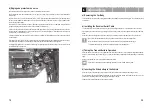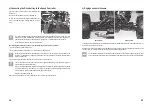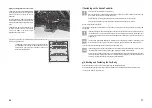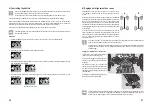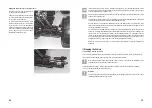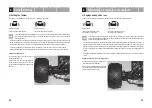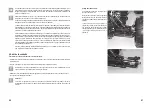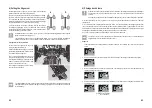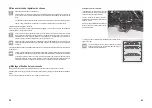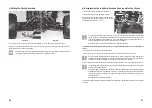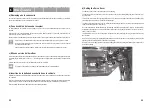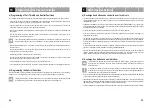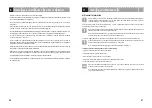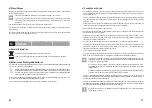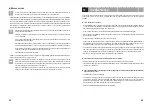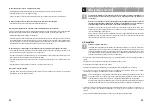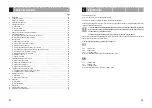
56
b) Mise en service
Le mode d’emploi de la télécommande est fourni séparément. Veuillez impérativement observer les
consignes de sécurité ainsi que toutes les autres informations qui y sont contenues !
• Utilisez uniquement des batteries de conduite appropriées (voir « Caractéristiques techniques »). En cas d’utilisation
d’une batterie de conduite inappropriée, il y a risque d’endommagement du véhicule (régulateur de vitesse, récepteur,
servos, moteur). N’utilisez jamais le régulateur de vitesse via un bloc d’alimentation, pas non plus à des fins de test.
• Lors de la mise en service, allumez toujours d’abord l’émetteur. La batterie de conduite du véhicule ne doit qu’ensuite
être raccordée au régulateur de vitesse avant de mettre en marche ce dernier. Le cas contraire, le modèle réduit
pourrait réagir de manière imprévisible !
Avant de raccorder la batterie de conduite, placez le véhicule sur une surface appropriée de sorte que les
roues puissent tourner librement.
Contrôlez la position de l’interrupteur marche / arrêt du régulateur de vitesse et mettez-le en position
« OFF » (désactivé).
Si cela n’est pas déjà fait, allumez l’émetteur. Assurez-vous de son fonctionnement correct (par ex. voyant
de fonctionnement de l’émetteur).
Raccordez une batterie LiPo à 4 cellules pleine au véhicule. L’adaptateur en Y fourni permet également
de raccorder les batteries LiPo à 2 cellules ; elles doivent alors être identiques et entièrement chargées.
Tenez fermement le véhicule en veillant à ne pas introduire la main dans le mécanisme d’entraînement, il
y a danger de blessure ! Ne tenez jamais le véhicule par les roues !
Allumez maintenant le régulateur de vitesse.
• Vérifiez si le véhicule réagit comme prévu aux ordres de la télécommande (direction et entraînement) avant de le
retirer du support et de poser ses roues sur le sol.
Réglez la compensation d’accélération / de freinage de sorte que le moteur ne tourne plus en cas de
relâchement total du levier de marche avant / arrière (position neutre du levier d’accélération / de freinage
sur l’émetteur). Le cas échéant, la position neutre et les positions plein gaz peuvent être reprogrammées
pour la marche avant et la marche arrière (voir chapitre 10).
Réglez la compensation de la direction de sorte que les roues avant restent quasi droites. Un réglage
précis pour une conduite en ligne droite peut être effectué plus tard, pendant la conduite.
49
13. Troubleshooting
Even though the model and the remote control system were built according to the state of the art, there may still be
malfunctions or errors. For this reason, we would like to give you some information on how to deal with possible
problems.
The model does not respond
• Is the throttle/brake lever in its neutral position? If the orange LED is lit at once after the speed controller is switched
on (the red LED does not flash first, no sound signals via the motor), reprogram the full throttle position for forwards
and reverse driving and neutral position, see chapter 10. a).
• Is the vehicle drive battery or are the batteries/rechargeable batteries in the transmitter discharged?
• Did you switch on the transmitter and then the speed controller? Correct: Always switch on the transmitter first and
then the speed controller!
• Is the drive battery connected to the speed controller correctly?
• Is the vehicle too far away? With a fully charged drive battery and fully charged batteries/rechargeable batteries in
the transmitter, the range should be 100 m and more. The range can be decreased by outside influences, such as
transmitters working on the same or an adjacent frequency (e.g. WLAN devices, Bluetooth, etc.).
• Check the correct position of the speed controller and steering servo plugs in the receiver. If the plugs are twisted by
180°, the speed controller and steering servo will not work (if the plugs of speed controller and steering servo are
swapped, the throttle/brake lever will control the steering servo and the wheel will control the driving function).
• Are the servo and speed controller plugs connected in the right orientation?
The vehicle does not stop when the throttle/brake lever is released
• Set the neutral position on the transmitter correctly by using the trimmer for the driving function.
• If the trimmer’s trimming path is not sufficient, put the trimmer into its centre position and then reprogram the speed
controller; see chapter 10. a).
The vehicle slows down or the steering servo shows only slight or no reaction; the range between transmitter
and vehicle is very short
• The drive battery is weak or discharged.
The receiver power supply and thus also the power supply of the steering servo is achieved through the speed
controller BEC. Therefore, a weak or discharged drive battery will cause the receiver to no longer work properly.
Replace the drive battery with a new, fully charged one (before inserting a new drive battery, wait at least 5 - 10
minutes until motor and speed controller have cooled down sufficiently).
• Check the batteries/rechargeable batteries in the transmitter.

